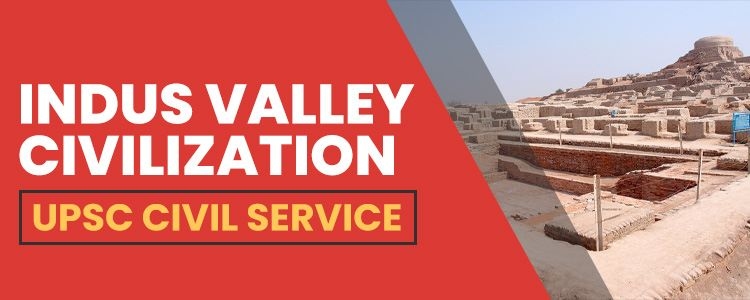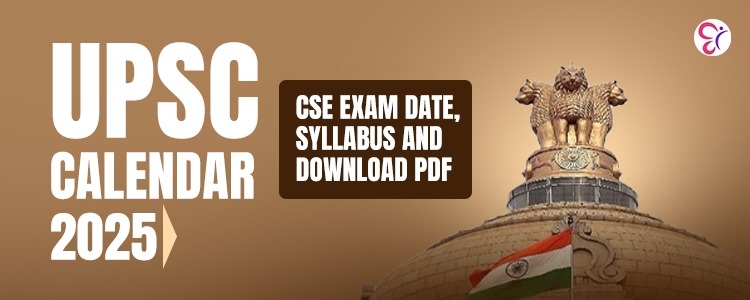Indus Valley Civilization - UPSC Civil Service

Indus Valley Civilisation also known as Harappan Culture dated between 2600 to 1900 B.C.E is one of the ancient civilisations with a largest archive of distinct objects like seals, beads, weights, stone blades and even baked bricks. Most of the artifacts were excavated from parts of Afghanistan, Jammu, Baluchistan (Pakistan) and Gujarat.
The Harappan Culture is often distinguished into Earlier Harappan Culture and Later Harappan Culture or Mature Harappan. Earlier Harappan Culture had been associated with pottery, evidence of agriculture, pastoralism with evidences of settlements. When it comes to Later Harappan Culture a creak in the lineage is evident with remnants of devasted and abandoned mass settlements.
1. Introduction To the Indus Valley Civilization
- Definition and Significance
Indus Valley Civilisation belonging to the bronze age period from 2600 to 1900 B.C.E was identified as one among the three early civilisations of the near East and South Asian area.
- Geographical Location and Extent
This early civilisation spanned from Pakistan, Northern Afghanistan to North-western India. The civilisation flourished along the alluvial plains of the Indus River that flows much past over the plains of Pakistan, and along the seasonal monsoon fed river networks near Ghaggra-Hakra, a seasonal river in north-west India and eastern Pakistan.
2. Indus Valley Civilization For UPSC: Historical Background
- Pre Indus-Valley Cultures and Settlements
Pre-Indus Valley Cultures were not known till 1920s, where the remnants of the Civilisation were excavated by the railway workers identifying the intricate artistic markings that too made out of soapstone which were used to lay down the railway tracks unknowingly.
- Emergence Of Indus-Valley Civilization
This led to the emergence of the Harappan Civilization, first of its sites which were excavated from the Punjab province in British India now in Pakistan.
- Chronology and Periodization
Earlier while on an excavation mission by a group of archaeologists unveiled the long-lost remnants of Indus Valley Civilization and initially thought it to be the ruins of Mauryan Empire that prevailed between 322 and 185 BCE.
The origin of Indian Civilization was thought to begun in the vicinity of the Ganges as Ancient Aryans inhabited areas most of these regions around 1250 BCE until the discovery of Indus Valley Civilization.
3. Indus Valley Civilization For UPSC: Urban Planning and Architecture
- Lay Outs and Structure of Cities
The most distinctive features of Harappan cities are their drainage system.
- Street Systems and Drainage Systems
The roads and streets were designed like approximate grid like pattern intersecting at right angles
- Major Cities of Civilization
Most of the Harappan settlements have a small western part and a large eastern section, however settlements like Dholavira and Lothal has an entire settlement that is fortified. The Citadel within Lothal was not walled and was built at a height.
Two sites of the Indus Valley Civilization were the cities of Harappa in the north and the cities of Mohenjodaro in the south.
The most unique features attributed to Harappan Civilisation is the development of distinctive urban cities.
- Mohenjodaro has been tagged the most important site, however Harappa was the one to be discovered first.
- Mohenjodaro was divided into two settlements a Citadel (Upper Town) and Lower Town.
- Citadel or Upper City had building constructed on mud brick platforms, which was walled and is also physically separated from the Lower City. Some of the peculiar constructions in Lower City includes,
- Great Bath- large rectangular tank in a courtyard
- Large Well- There were rooms on three sides, out of which one was the Large Well
Source: http://moonworldhistory.weebly.com/indus-valley.html
4. Indus Valley Civilization For UPSC: Trade and Economy
- Trade Networks and Route
Other Archaeological findings suggest that copper was probably taken from Oman on the south-eastern tip of Arabian Peninsula. And the traces of such excavated copper also had remnants of Nickel that confirms a contact as well. A large Harappan Pot coated with black clay was also found near Omani sites too.
- Agri Cultural Practises and Food Production
The pre-dominance of agricultural practices was established by the traces of grains in the excavation region. And there were many stipulations on whether the seeds were sowed in ploughed lands or not. However, the indications on the seals and terracotta sculpture shows that bulls were domesticated in that time.
- Craftsmanship and specialized industries
Stone statues: There were a refined collection of stone, bronze or terracotta statues in Harappan sites.
Bronze Casting: bronze casting were practices on a wide scale by Harappans. They were mainly made using lost wax technique where the wax figures were coated with clay and allowed to dry.
Terracotta: Terracotta structures of human figures were of the crude form in the Indus Valley civilization.
Seals: Archaeologists have recovered seals made of steatite, agate, chert, copper, faience and terracotta with beautiful figures of animals such as unicorn bull, rhinoceros, tiger, elephant, bison, goat, buffalo etc.
|
Important Sites & Findings | ||
|
Site |
Excavated by |
Excavation Findings |
|
Harappa |
Daya Ram Sahini |
Sandstone statues of Human anatomy, Granaries, Bullock Carts |
|
Mohenjodaro |
R D Banerjee |
Great Bath, Granary, Bronze dancing, Seal of Pasupathi Mahadeva, Steatite statue of beard man, A piece of woven cotton |
|
Suktagendor |
Stein |
A trade point between Harappan and Babylonia |
|
Chanhudaro |
N G Majumdar |
Bead makers shop, Footprint of a dog casing a cat |
|
Amri |
N G Majumdar |
Antelope evidence |
|
Kalibhangan |
Ghose |
Fire altar, Camel bones, Wooden plough |
|
Lothal |
R Rao |
First man-made port, Dockyard, Rice husk, Fire altars, Chess playing |
|
Surkotada |
J P Joshi |
Bones of horses, Beads |
|
Banawali |
R S Bisht |
Beads, Barley, Evidence of pre-Harappan and Harappan Culture |
|
Dholavira |
R S Bisht |
Water harnessing system, reservoir |
5. Indus Valley Civilization For UPSC: Social and Political Organization
- Social hierarchy and Class divisions
The remnants of social life in Indus Valley Civilization indicated a rich and organised culture. The people of the civilization were divided into four main classes namely the learned class, the warriors, traders, artisans and manual labourers. Women were given a respectable position in the society and agriculture was the main occupation where cattle were domesticated.
- Governance and Administrative systems
Cities in Indus Valley were characterized by a densely populated mob, which was closely knit on the economic and social lines, technology driven economic developments and careful planning for expansion of trade & commerce.
- Religion, Beliefs, and Rituals
Studying the Burials, archaeologists generally use certain strategies to find out whether the people lived within a particular culture or whether there existed any socio-economic differences between the people. The burials in Harappan civilisation were quite peculiar with hallowed out pits where some pits were laid out with bricks whereas others without any brick lining.
Another strategy that was used to identify the social differences were by studying the artefacts. First of all, objects of daily utility were analysed to check whether they were made out of clay or stone.
6. Indus Valley Civilization For UPSC: Technological Advancements
- Pottery and Ceramics
Pottery that was painted, plain and decorated were found from the excavation sites of Harappa. And the utensils and kitchen wares were shaped on a potter’s wheel, however the potter wheel made out of wood did not sustain.
- Metallurgy and Metalworking
Indus Valley Civilisation also known as Sindhu-Saraswathi civilization has been recognised as one with advanced innovations in metal works accounting for the various techniques like the lost wax technique, lost saw and eye needle.
- Sewage and Sanitation Systems
Most of the residential blocks in Indus Valley Civilisation was built using baked bricks and clay bricks. The constructions in many parts of Mohenjo-Daro include two storeys building and had well defined drainage system to expel the waste materials from the place of residence. Every court yard had a washing platform and a dedicated toilet or waste disposal hole.
7. Indus Valley Civilization For UPSC: Writing and Script
- Indus Script and Decipherment Attempts
Indus Valley civilization least understood in terms of the scripts they used to communicate or express. It is one of the still undeciphered texts that have a long-lost significance when compared to other Indian writing systems like Brahmi, Devanagari and Bengali script. And there is no bi-lingual text to decipher the actual scripts used by the Indus Valley people.
- Epigraphic Evidence and Inscriptions
The inscriptions found were really short with an average length of inscription being around five signs and the longest ever found was from the mature Harappan period inscribed on a Copper plate. And there are doubts whether the Indus scripts is an extension of any written language or simply being a system of non-linguistic signs or proto-writing.
8. Indus Valley Civilization For UPSC: Decline and Legacy
- Theories on the decline of the civilization
Many theories have been strived in order to give a better explanation for the abrupt decline in a civilization so sophisticated in its culture and practices. Some among the most proposed ones are as follows.
- Aryan invasion: Aryans or an Indo-European tribe, thought to have invaded and destroyed the culture and civilization
- Climate change: Many scholars believe that there has been a mass shift the climatic conditions causing erratic change in the topography of the entire settlement making life almost impossible.
- Eastward shift of monsoon patterns: the eastward shift of monsoons may have influenced the water supply availability in the place
- Influence on subsequent cultures and civilizations
Harappan Arti crafts display an extraordinary style of perfection and uniformity. The seals, pottery, coins and bricks have standardized sizes and weights which is not expected of an age-old culture.
- Indus Valley Civilization in modern times
The craft specialization indicates that there has been some level of socio-economic distinction that prevailed in the Indus valley Civilisation. And the geographic position of the Indus Valley Civilisation attracted less enemies on the warfront.
9. Is Indus -Valley Civilization Is Important in UPSC Exams?
- Relevance of studying the Indus Valley Civilization for UPSC
Indus Valley Civilization always have a special place in history especially a prominence in the bronze era of ancient history. The major artifacts and antiquities excavated and their location of existence is of profound importance for Civil Service exam preparation.
Possible questions and Topics in the exam for which more importance must be given are detailed below,
- Indus Valley Civilization and its three phases of development viz., Early Harappan Phase, Mature Harappan Phase and Late Harappan Phase
- Town planning and structures
- Agriculture, Economy and Crafts
- Excavation Sites and Artifacts
UPSC History notes can be curated systematically so that the notes alone will serve as the main source of study in the due course of learning.
Trending Updates







